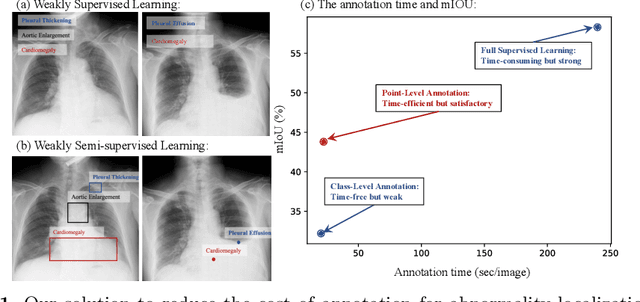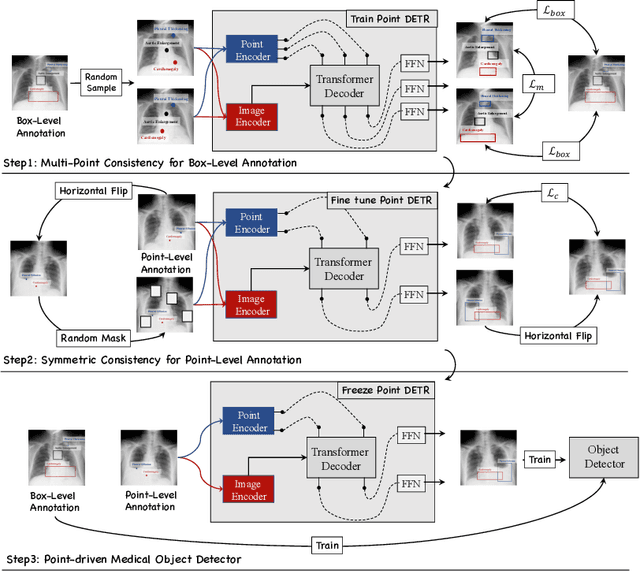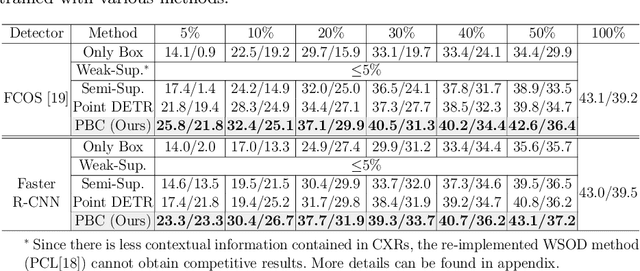Haoqin Ji
A Benchmark for Weakly Semi-Supervised Abnormality Localization in Chest X-Rays
Sep 05, 2022



Abstract:Accurate abnormality localization in chest X-rays (CXR) can benefit the clinical diagnosis of various thoracic diseases. However, the lesion-level annotation can only be performed by experienced radiologists, and it is tedious and time-consuming, thus difficult to acquire. Such a situation results in a difficulty to develop a fully-supervised abnormality localization system for CXR. In this regard, we propose to train the CXR abnormality localization framework via a weakly semi-supervised strategy, termed Point Beyond Class (PBC), which utilizes a small number of fully annotated CXRs with lesion-level bounding boxes and extensive weakly annotated samples by points. Such a point annotation setting can provide weakly instance-level information for abnormality localization with a marginal annotation cost. Particularly, the core idea behind our PBC is to learn a robust and accurate mapping from the point annotations to the bounding boxes against the variance of annotated points. To achieve that, a regularization term, namely multi-point consistency, is proposed, which drives the model to generate the consistent bounding box from different point annotations inside the same abnormality. Furthermore, a self-supervision, termed symmetric consistency, is also proposed to deeply exploit the useful information from the weakly annotated data for abnormality localization. Experimental results on RSNA and VinDr-CXR datasets justify the effectiveness of the proposed method. When less than 20% box-level labels are used for training, an improvement of ~5 in mAP can be achieved by our PBC, compared to the current state-of-the-art method (i.e., Point DETR). Code is available at https://github.com/HaozheLiu-ST/Point-Beyond-Class.
Robust Representation via Dynamic Feature Aggregation
May 16, 2022



Abstract:Deep convolutional neural network (CNN) based models are vulnerable to the adversarial attacks. One of the possible reasons is that the embedding space of CNN based model is sparse, resulting in a large space for the generation of adversarial samples. In this study, we propose a method, denoted as Dynamic Feature Aggregation, to compress the embedding space with a novel regularization. Particularly, the convex combination between two samples are regarded as the pivot for aggregation. In the embedding space, the selected samples are guided to be similar to the representation of the pivot. On the other side, to mitigate the trivial solution of such regularization, the last fully-connected layer of the model is replaced by an orthogonal classifier, in which the embedding codes for different classes are processed orthogonally and separately. With the regularization and orthogonal classifier, a more compact embedding space can be obtained, which accordingly improves the model robustness against adversarial attacks. An averaging accuracy of 56.91% is achieved by our method on CIFAR-10 against various attack methods, which significantly surpasses a solid baseline (Mixup) by a margin of 37.31%. More surprisingly, empirical results show that, the proposed method can also achieve the state-of-the-art performance for out-of-distribution (OOD) detection, due to the learned compact feature space. An F1 score of 0.937 is achieved by the proposed method, when adopting CIFAR-10 as in-distribution (ID) dataset and LSUN as OOD dataset. Code is available at https://github.com/HaozheLiu-ST/DynamicFeatureAggregation.
 Add to Chrome
Add to Chrome Add to Firefox
Add to Firefox Add to Edge
Add to Edge